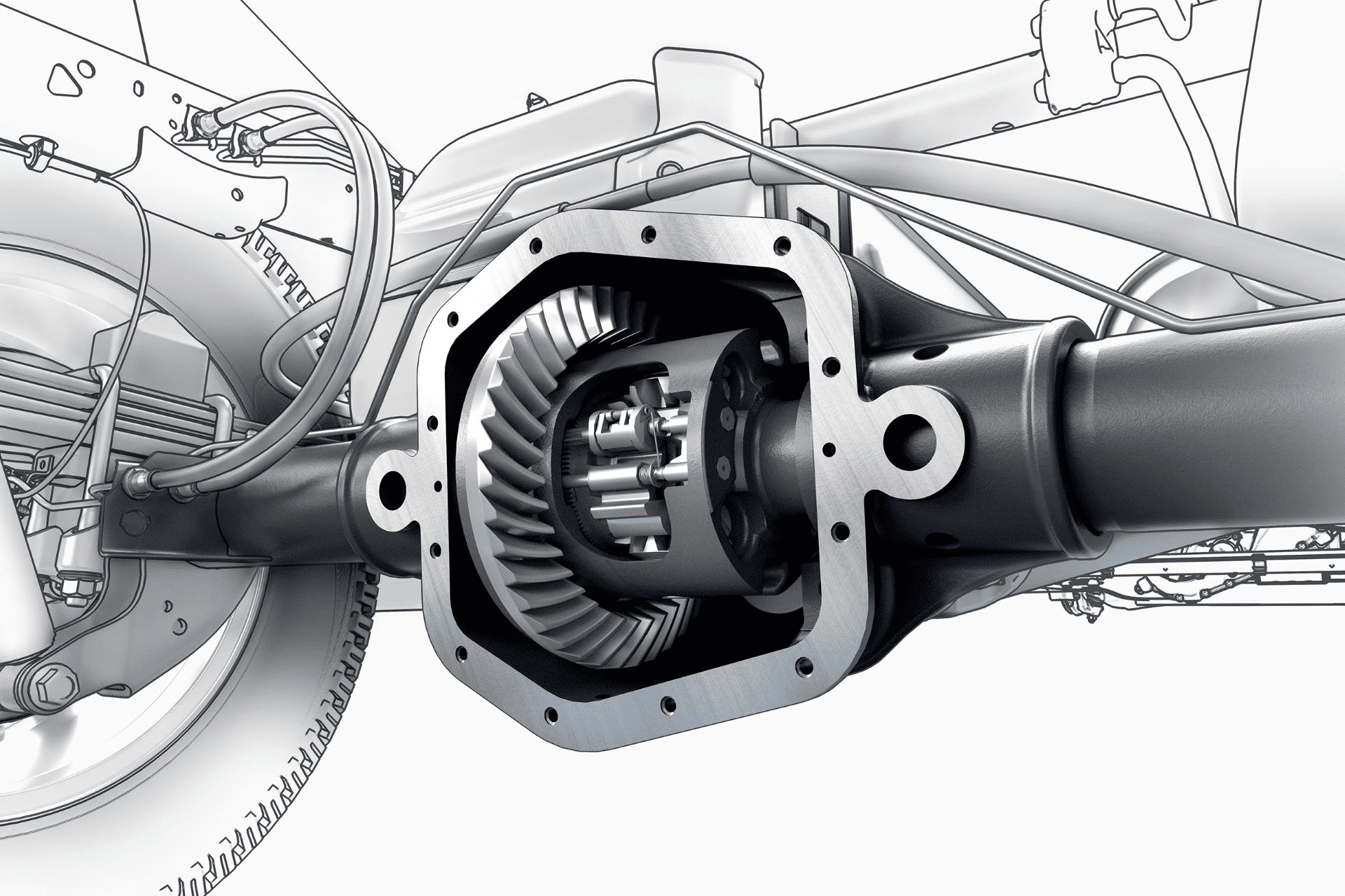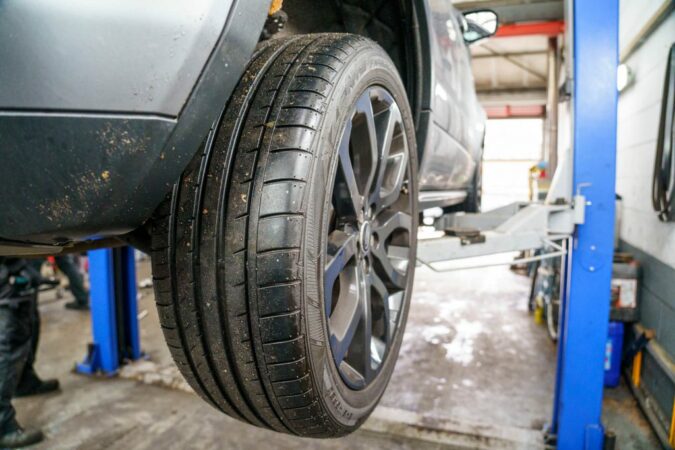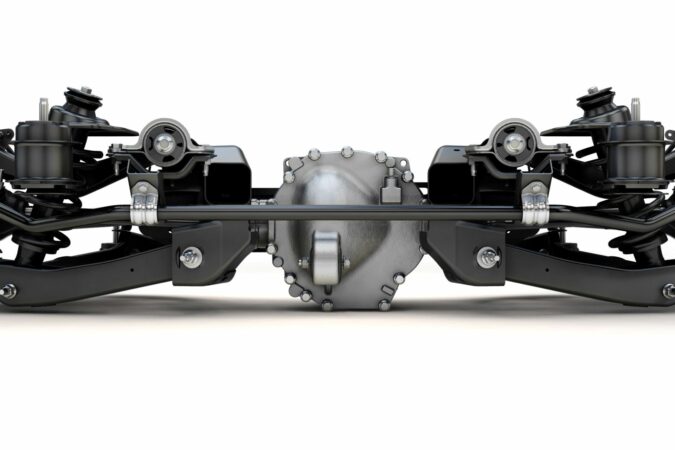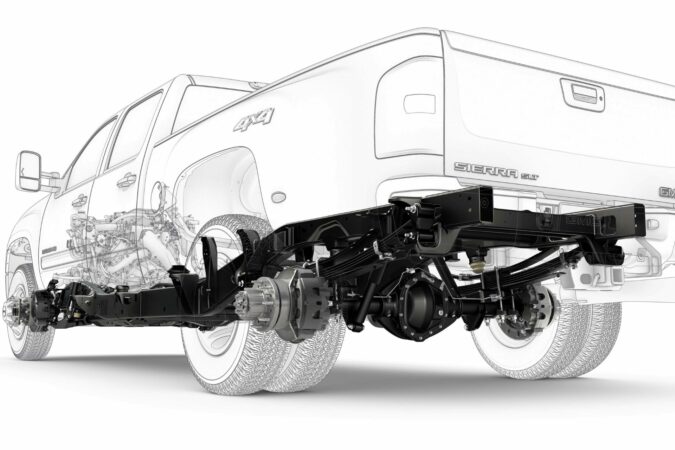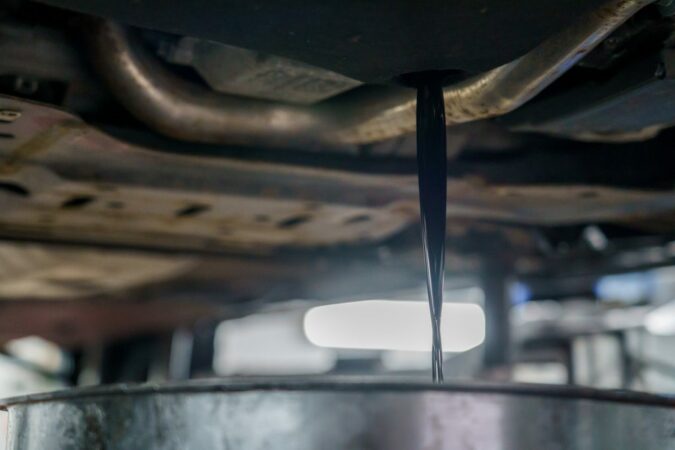In a front-wheel-drive car, the differential is incorporated into the gearbox casing and uses the same lubricant. However, in a rear-wheel-drive vehicle (RWD), the differential is located at the rear and is frequently neglected during routine services. Rear differential fluid is a slick oil film that allows the gears inside the differential to move around easily.
This fluid needs to be replaced periodically. To lubricate the gears and bearings in their differential, rear-wheel drive and certain front-wheel drive cars and trucks utilize gear oil or differential fluid. This fluid is a highly-viscous oil that can keep lubrication even when subjected to high stresses.
Gear oil or differential fluid comes in grades that are synthetic or conventional in nature. Without the lubricating abilities of this high-pressure gear oil, friction will soon wear through the unique layer of hardened steel on the gear teeth. This causes the gears to break prematurely.
This article’s goal is to demonstrate to you how simple and painless servicing your rear differential is. We will also go through the rear differential fluid changing interval and the replacement process in detail.
- What Is A Rear Differential
- Types Of Differentials
- Rear Differential Fluid
- Rear Differential Fluid Change
- Rear Differential Fluid Change Cost
- Final Conclusion
- FAQs
Differential
Let’s start by discussing the fundamentals of the car differential, whether it be a gas, diesel, hybrid, or electric vehicle. A driveshaft or in the case of a front-wheel-drive vehicle a front differential transaxle transmits a particular amount of power from the engine to the wheels.
This driveshaft’s output must be divided in order to power the set of two wheels. This is where differentials play their part. They distribute the wheels’ power while allowing them to move at various speeds. So then what exactly is a differential? The differential is a pivotal part of the front or rear axle assembly.
It enables you to turn without the drivetrain winding up. Power is split using a series of gears in the rear differential after the engine transfers it through the gearbox to a driveshaft connected to it. The number of revolutions per minute that each wheel makes can be altered using these gears.
Why so? Well, imagine a car making a simple left U-turn and what the front and rear wheels are doing at the same time. In this case, the inner or left wheels here have a significantly shorter distance to travel than the outer or right wheels. This is made possible by a differential’s gearing.
It will make it possible for the inner tire to rotate at a lower rpm while the outer tire spins at a higher rpm. Regardless of whether you’re driving a rear-, front-, or all-wheel-drive car, a differential is what makes the wheels spin.
When you press the gas pedal, the differential’s gears transfer engine energy to the axles. This enables the axles to spin the wheels in the proper direction and at the proper speed.
Rear Differential
Differentials are present in some form in every vehicle. In front of front-wheel-drive cars, the differential is located in the front and is referred to as a transaxle. Vehicles with rear-wheel drive, have the differential located at the back. In the case of four-wheel drive vehicles differentials are present in both the front and the rear.
The differential, which is a component of the driveline and is situated where the driveshaft connects to the axle, is situated between the wheels. A differential simply allows for different wheel speeds.
For instance, the outside tire needs to move more quickly to keep up with the inner tire when turning a corner. This is because the outside wheel travels a longer distance than the inside wheel. Your tires would skip and jump throughout a turn if you didn’t have a differential.
Types Of Differentials
There have been three different types of differentials for many years: open, limited-slip, and locked differentials. There are now a few more examples on the list thanks to developments in drivetrain technology.
Some electric cars include an integrated electric motor that eliminates the need for a conventional car differential entirely. The most frequent production-related differentials are listed below-
Types Of Differentials #1: Open Differential
Two half shafts with a gear at either end can be found in an open diff. Power for these gears comes from the primary ring gear, which is attached to the drive shaft by a pinion gear. Between the two half-shaft gears, there is a smaller spider gear that is static when the vehicle is traveling straight but engages when the vehicle is turning.
This differential has the advantage of being inexpensive to create and functioning flawlessly in the majority of situations. The path of least resistance is usually followed by power, which is a drawback. As a result, the wheel will eventually spin pointlessly in low grip conditions.
Some FWD performance vehicles equipped with an open differential may develop torque steer when accelerating hard. Hence, why folks wonder whether you can drift with an FWD car.
Types Of Differentials #2: Locking Differential
A locking differential is essentially an open differential with the added ability to lock the wheels in place. With both wheels moving at the same speed, this effectively produces a fixed axle.
Off-roaders are generally the target audience for this type of differential. As you may guess, trying to climb a rocky incline while one wheel is spinning freely is useless. A truck or an SUV will have higher traction when both wheels are turning at the same pace.
For the best possible off-road grip, hardcore off-roaders also come with front differential lockers. For example, lockers are available for the front and rear of a Jeep Wrangler Rubicon.
Types Of Differentials #3: Limited-Slip Differential
Although it only typically appears in rear-wheel drive (RWD) performance cars, a limited-slip differential (LSD) combines the best of both worlds. The two wheels can spin independently with the aid of an LSD, but only up to a certain speed.
The majority of high-performance sports car models and serious four-wheel-drive (4WD) vehicles have this feature since it increases traction. LSDs come in two varieties: mechanical clutch versions and viscous LSDs.
The mechanical clutch LSD has pressure rings that exert pressure on the clutch plates next to the gears. This causes the differential to lock. This is how, for example, the Auto LSD system works in a Toyota Tacoma.
Additionally, the clutches can be electronically controlled, which is how the majority of all-wheel-drive vehicles operate. However, a center differential can be electronically activated to engage the rear wheels in all-wheel-drive (AWD) cars, which are typically front-wheel-drive most of the time.
It is significantly easier to set up a viscous LSD. Instead of the aforementioned clutch plates, a thick viscous fluid is employed. When this liquid is subjected to force, it becomes stiffer and locks the differential. Problems may arise if it gradually loses its viscosity. But regular maintenance should keep it in fine shape (as is knowing how to reset maintenance light on Toyota Corolla).
Types Of Differentials #4: Torsen Differential
The setup of a Torsen differential is identical to that of an open differential, but the bevel gears are surrounded by additional “worm gears.” Most of the time, a Torsen differential is open, distributing torque equally between the front and rear axles.
However, it differs in function when a wheel on a given axle begins rotating more quickly than the opposing wheel. In that situation, the pinion gears and worm gears bind together in such a way that power is transferred to the slower-spinning wheel.
Multiple worm gear designs are supported by the Torsen differential, allowing for manufacturer customization.
Types Of Differentials #5: Active Differential
The clutches in this differential are regulated electronically as opposed to using mechanical components as in a limited-slip differential. This method has a lot of advantages while being expensive.
When fitted with multiple sensors, the vehicle’s ECU is capable of performing millions of computations per second to determine which wheel needs to be powered.
Types Of Differentials #6: Torque Vectoring Differential
This is an improvement above the conventional limited-slip diff. When there is a significant speed difference, a torque vectoring system can restrict power on one side and boost torque.
This is instead locking the differential with clutches. High-end performance automobiles frequently use this because it enables a sharper turn-in. A larger vehicle can perform in a more agile manner with torque vectoring and rear-wheel steering.
Rear Differential Fluid
Axles for each rear wheel are connected to the driveshaft that exits the engine at the rear differential. There are three sets of gears rotating, and every gear requires lubrication.
It must, regrettably, be replaced in regular intervals – like every 30,000-60,000 miles, which may vary from one vehicle to another. When the differential needs to be drained for axle service it’s a great opportunity to change the rear differential fluid.
However, it’s always advisable to reference your owner’s or auto repair manuals for the right intervals. The enormous pressures delivered by the differential gears’ continuous lashing cannot be handled by simply ordinary oil.
The shocks and loads produced when engine torque and horsepower are transferred to the wheels must be handled by the oil. A significant portion of this high-pressure lubricant was made from sperm whales until commercial whaling was banned in the 1970s. These substances have now been superseded by modern synthetic alternatives.
Choosing The Right Rear Differential Fluid
While choosing a differential fluid, proper viscosity or weight should be taken into account. The GL rating comes next. It is best to use only what is recommended for your differential. If the handbook specifies a 90W gear oil with a GL-5 rating, the only option is to use it.
Second-guessing the engineers and using the incorrect gear oil can ultimately result in expensive rear differential repairs. The requirements of the limited-slip or traction-sensing differential should be taken into account when choosing a differential fluid.
The torque, or twist, produced by the driveline is always applied to both wheels in a normal or “open” differential. This happens regardless of whether one of those wheels happens to be spinning hopelessly on an icy surface.
In the case of a limited-slip differential (LSD) when this energy is lost, it detects it and shifts torque to the wheel with the most traction. The miracle of redirected traction is achieved by a variety of mechanisms. But for the majority of them to function properly, they need friction modifiers that are exclusive to their particular design.
Without these specialized lubricants, an LSD will at best perform suboptimally and at worst completely fail. This necessitates spending a fortune to rebuild and repair the rear differential. If your vehicle has an LSD, make sure to use gear oil that is formulated with the appropriate friction modifiers for that LSD.
Rear Differential Fluid Change
This might be a very messy or a very tidy job, depending on the differential’s design. Some differentials need you to remove the housing cover, while others feature a drain plug. You’ll need a large catch pan in any situation. Also, putting a plastic dropcloth underneath it might be wise.
Change into your soiled clothes because you’ll probably get dirty during the process. Before beginning the process, drive your car for a few minutes to warm the oil. It’s just changing the oil, right? There’s nothing really complicated, but brace yourself. The smell of used differential oil in cars is the worst there is.
There are two main types of car differential designs, and both require the differential fluid to be changed. The first one has a top fill plug and a bottom drain plug and is simpler to change. For the second type, you have to take off the cover.
If you’re doing a differential fluid change in a tall SUV or truck, you probably don’t need to elevate the vehicle. If you can’t, be sure to raise the front and back of your vehicle to the same height. Otherwise, you won’t be able to drain all the fluid and replenish it with the appropriate quantity.
Drain Plug Differential
Cleaning the vicinity of the drain (bottom) and fill (top) plugs comes first in this procedure. You don’t want any dirt to enter the housing along with the new fluid. The fill plug must be opened in the subsequent step.
It’s better to learn that if your fill plug is stuck when your car is still roadworthy rather than when the differential is completely empty. After taking out the fill plug, take out the drain plug as well. Followed by this, use a pan to collect the used fluid.
You might want to do this outside because the stench of old gear oil is awful. Reinstall the drain plug properly after the differential has been emptied. Be careful to change the washer if it has one because doing so will assist to prevent leaks.
Next, fill in the differential with fresh fluid. Some vehicles will need a differential fluid pump, but some have enough clearance that you can use the bottle to pour. Check your car’s manual to find out where the fill line is.
However, full often means the fluid is dripping out of the opening. But be careful not to overfill. Otherwise, your differential may become a fluid mixer. Place the fill plug in and at the same time, replace the washer if necessary.
Closed-Case Differential
The complete rear housing must be taken out for this type of differential. Because you have to re-seal the lid, it is messy and requires additional work. As earlier, take out the fill plug first and loosen out each differential bolt. Remove the lower bolts while the upper bolts should be left with some slack.
As soon as the bottom bolts are loosened, the differential might start to drain. However, it might also stay stuck. Try to loosen the case using a flat screwdriver from your Blue Point tools kit but be careful not to distort the flange. Remove the cap after letting it drain.
To remove any leftover gear oil and the metal shavings in them, wipe off the housing’s interior and lid. After that, wipe the mating surface of the housing and the cover using a razor scraper or a soft abrasive pad. Clean and wipe using brake cleaner or something similar.
Some vehicles employ a gasket, while others use gasket material, which is a specific kind of silicone adhesive intended to keep the oil within. Bolt the cover into place after applying a single bead (thicker isn’t necessarily better) all the way around the cover and in each hole.
Tighten the cover to the specifications of your vehicle after allowing the gasket maker to dry as directed. Make sure you don’t make it too tight.
Rear Differential Fluid Change Cost
The price of changing your differential fluid will be slightly higher than the cost of replenishing your engine oil. The expense of changing the fluid in the front differential differs from the cost to change the rear differential fluid.
The anticipated overall cost is a little more for changing the rear differential fluid. It ranges from $80-$150 on average. Changing the rear differential fluid require labor cost that ranges from $50 to $70 and the fluid itself cost between $30 to $80.
You can keep costs down and avoid any unneeded repairs or replacements by being aware of the average rear differential service cost of your vehicle. You can keep the overall differential fluid change cost as low as possible by recognizing the warning signs and symptoms.
Factors Affecting Rear Differential Fluid Change Cost
1. Your Location And The Local Labor Rates
The mechanic labor rate will be varied depending on where you live. Labor costs are lower in some regions of the nation than in others. Additionally, compared to the city, the labor rate is typically substantially lower in the country. The cost of taking your car to the neighborhood lube shop will also be less than going to the dealership.
If you don’t go to a shop with trained experts, though, you get what you pay for and your car will be serviced by less qualified mechanics. If you perform the task on your own it would obviously be the least expensive option. You could save money if you change the differential fluid yourself provided you have the tools and knowledge.
2. Amount Of Differential Fluid Required
Like engine oil, differential oil also has different prices. Your costs will go up if you choose synthetic oil. You pay for different properties and consistency as well. Keep in mind that each differential can require a different kind of oil.
The quantity of differential oil required must also be taken into account. The amount of gear grease stored in each axle varies. During a change, the majority of systems will only need one gallon or less. Your service handbook will have more information on this.
Rear Differential Fluid: In Conclusion…
Differential fluid ensures that the differential continues to function at its best for a long time. Differential fluid, sometimes known as gear oil is located inside the axle housing. Unlike engine oil, which is made to operate at high temperatures, gear oil is made to operate under high pressure.
If there was no differential fluid, metal-on-metal contact would cause the differential to overheat. That implies that it would eventually burn out, maybe pose a safety risk, demanding costly repairs. As we’ve discussed previously, the cost to replace the front or rear differential is expensive.
The differential fluid should typically be changed every 30,000 to 60,000 miles, but always refer to your owner’s manual for precise maintenance recommendations. This is an intermediate-level repair process. At least, changing the fluid is easier than something like fixing a front diff leak.
However, it can become challenging on vehicles that are lower to the ground or that have suspension parts blocking the differential cover. If you are unsure of what to do, have an expert examine the differential. However, keep in mind that replacing the differential fluid is not a process that you should skimp on.
FAQs On Rear Differential Fluid
What Is A Rear Differential
Your car’s rear differential is a component that allows the crankshaft to generate torque before the transmission distributes it to the driveshaft and wheels. Overall, the rear differential allows each wheel to rotate at various rates while still transferring engine power to them. This is especially essential during turns.
What Does The Differential Do
The differential enables the different driving wheels on the same axle to rotate at various speeds. It especially works especially when the car is driving through a turn. Differentials are low-maintenance, sealed parts that are anticipated to last the life of the vehicle. However, need to be serviced at regular intervals in order to check and/or replenish the oil.
What Is Differential Fluid
Your differential is transmitting a lot of torque, putting a lot of strain on the gears inside it. They need to be properly lubricated in order to last. This is taken care of by the differential fluid or gear oil which is used in every differential. The internal gears, bearings, and other parts are all lubricated and kept cool by the differential fluid.
How Often To Change Differential Fluid
The differential fluid should typically be replaced every 30,000 to 60,000 miles according to manufacturer maintenance schedules. However, this can vary depending on the make and model. Although the replacement process is actually rather simple, it might get messy if you decide to do it at home.
How Much Does It Cost To Replace A Rear Differential
A complete rear differential replacement typically costs between $1000 and $4000. You would have to spend between $400 and $1,000 for a rebuilt differential. On the other hand, a brand-new differential typically costs between $1,000 and $2,000. Most people won’t be able to complete the replacement process on their own and will need the assistance of a skilled professional.
How Long Does It Take To Replace A Rear Differential
The housing, gears, bearings, and seals are all replaced during a complete rear differential replacement. A complete differential rebuild typically takes a qualified mechanic three to five hours to complete in a shop. Without proper prior experience, a rear differential replacement could take significantly longer.
What Happens If Rear Differential Goes Out While Driving
The differential enables the tires to rotate at various speeds while turning. When it goes out, the gears grind, causing the tires to rotate at the same speed. This results in the tires wearing out. Rear wheel sidewall or outside tire degradation is a strong indicator that your differential may be failing.

